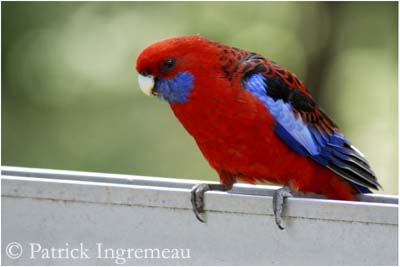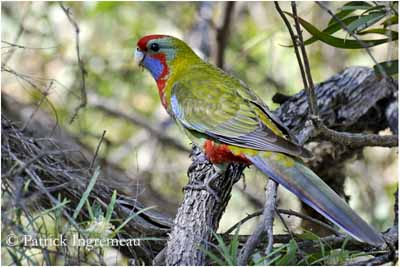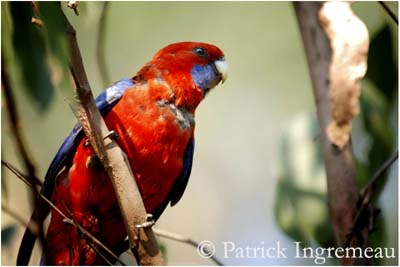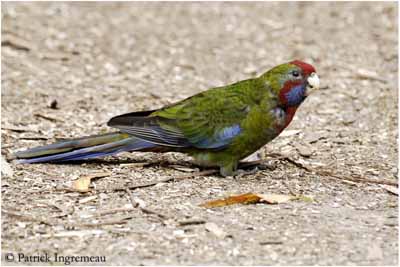
Crimson Rosella
Platycercus elegans
Psittaciforme Order – Psittaculidae Family
BIOMETRICS:
Length: 36 cm
Weight: 115-170 gr
DESCRIPTION:
Crimson Rosella’s French name comes from the naturalist Thomas Pennant (1726 – 1798).
Adult male has mainly red plumage. On the upperparts, back, rump and scapulars are black with conspicuous red edges, giving strong scaled effect. The long, graduated tail is blue, with tipped pale blue outer rectrices. On the upperwings, the lesser coverts are black. The outer median and secondary coverts are pale blue. The outer secondary flight feathers are pale blue too. The other flight feathers are blackish-blue.
On the underparts, breast, belly, undertail coverts and flanks are red. The undertail feathers are pale blue-grey. Underwings show deep blue coverts and blackish flight feathers.
The head is red, with deep blue cheeks and chin.
The hooked bill is greyish-white. Eyes are dark brown. Legs and feet are grey.
DIET:
Crimson Rosella feeds mainly on seeds and fruits. It may sometimes catch insects and larvae. It feeds in small groups in trees and bushes, and on the ground.
PROTECTION / THREATS / STATUS:
Crimson Rosella is common and abundant in its range. The main threat for this species is the land clearance, causing habitat loss. But at this moment, the species is not threatened.
Fr: Perruche de Pennant
All : Pennantsittich
Esp : Perico Elegante
Ital : Rosella di Pennant
Nd : Pennant-rosella
Russe : Малиновая розелла
Photographs by Patrick Ingremeau
TAMANDUA
Text by Nicole Bouglouan
Sources:
HANDBOOK OF THE BIRDS OF THE WORLD vol 4 by Josep del Hoyo-Andrew Elliott-Jordi Sargatal - Lynx Edicions - ISBN: 8487334229
PARROTS OF THE WORLD – An Identification Guide – by Joseph M. Forshaw – Princeton University Press – ISBN 0691092516
Birds in backyards (Birds Australia and Australian Museum)
New Zealand birds and birding (Narena Olliver)
Welcome to the Australian Museum

Both sexes are similar, but female has washed green tail and slightly smaller bill.
Juvenile has green plumage on mantle, uppertail, breast and belly. On the back, a light scaled effect is made by blackish edges. On the underparts, throat is washed red, and vent and undertail coverts are red. It has a whitish band across the flight feathers.
It has blue chin and malar area, and red forehead, crown, cheeks and throat.
It reaches it adult plumage at 15 months old.
Crimson Rosella has several colour forms, and mainly three. We can find:
Crimson forms: P.e. elegans; P.e. nigrescens; P.e. melanopterus.
Orange-red and yellow forms: P.e. fleurieuensis; P.e. subadelaidae.
Yellow form: P.e. flaveolus.
Crimson Rosella has three subspecies:
P.e. elegans;
P.e. nigrescens is darker and smaller;
P.e. melanopterus is blacker on the back.
VOICE: SOUNDS BY XENO-CANTO
When in flight, Crimson Rosella utters a common two-syllabled “cussik-cussik” as contact call. It gives metallic whistles “chinka-chink…chinka-chink” in threat behaviour. It utters harsh screeches when alarmed.
HABITAT:
Crimson Rosella frequents the coastal regions and the nearby upland forests and the rainforest edges. It is often seen in tall eucalypt forests. This species is visible from sea-level up to 1900 metres of elevation. It is sometimes found in the suburbs of cities such as Canberra and Adelaide where numbers are increasing.
RANGE:
Crimson Rosella lives in Australia where there are several populations. We find it in north-eastern Queensland, in south-eastern Queensland to the south-eastern South Australia, and on Kangaroo Island.
This species has been introduced in New Zealand and on Norfolk Island.

BEHAVIOUR:
Crimson Rosella feeds mainly on seeds of eucalypts, native pines, acacias, and of introduced plants’ species. It also feeds on fruits, and is sometimes considered as pest in orchards. It may catch some insects and larvae.
It often forages in small groups and may become familiar with humans in gardens. It feeds on the ground, in trees and bushes.
But it is usually seen in pairs or small family groups. They are more active in the morning and in the late afternoon. During midday, Crimson Rosella rests in shaded foliage.
They sleep at night at communal roosts. Flocks are noisy and conspicuous when they arrive at nighttime roost, and when they leave it at sunrise.
When a flock is disturbed or threatened, the birds shelter in trees and foliage. However, Crimson Rosella may be very tame when living in urban areas.
It is mainly sedentary in its range, but it may perform nomadic movements in winter at the boundaries of the range.
FLIGHT:
As other Psittacidae, Crimson Rosella has fast flight with shallow wing beats.

REPRODUCTION:
Breeding season occurs between August and February, sometimes later.
Crimson Rosella adults form permanent pairs, remaining in contact all year round.
When breeding season starts, both mates of the pair perform courtship feeding and displays. The male squares the shoulders, erects the breast feathers and the tail coverts, and wags the fanned tail. This display is accompanied by chattering.
It nests in cavity, such as hole in tree trunk or branch. It usually prefers the eucalypt, live or dead, but near water.
Female lays 2 to 4 white eggs. Incubation lasts about 19 to 20 days, by female. The male feeds her sometimes, but she leaves briefly the nest to forage herself too.
The chicks are brooded and tended by the female the first days, but then, both parents share the nesting duties.
Young leave the nest about 5 weeks after hatching, and become independent one month later. They remain in family group until the next breeding cycle.
